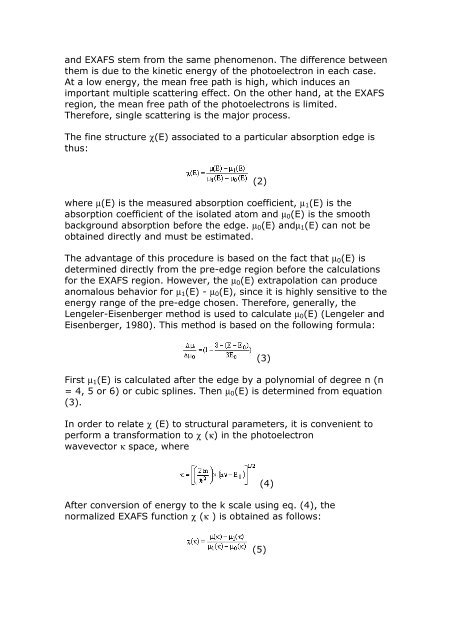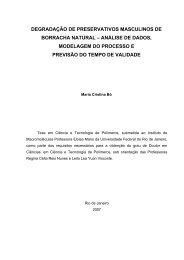EXAFS as a tool for catalyst characterization: a review of the ... - INT
EXAFS as a tool for catalyst characterization: a review of the ... - INT
EXAFS as a tool for catalyst characterization: a review of the ... - INT
You also want an ePaper? Increase the reach of your titles
YUMPU automatically turns print PDFs into web optimized ePapers that Google loves.
and <strong>EXAFS</strong> stem from <strong>the</strong> same phenomenon. The difference between<br />
<strong>the</strong>m is due to <strong>the</strong> kinetic energy <strong>of</strong> <strong>the</strong> photoelectron in each c<strong>as</strong>e.<br />
At a low energy, <strong>the</strong> mean free path is high, which induces an<br />
important multiple scattering effect. On <strong>the</strong> o<strong>the</strong>r hand, at <strong>the</strong> <strong>EXAFS</strong><br />
region, <strong>the</strong> mean free path <strong>of</strong> <strong>the</strong> photoelectrons is limited.<br />
There<strong>for</strong>e, single scattering is <strong>the</strong> major process.<br />
The fine structure χ(E) <strong>as</strong>sociated to a particular absorption edge is<br />
thus:<br />
where µ(E) is <strong>the</strong> me<strong>as</strong>ured absorption coefficient, µ 1 (E) is <strong>the</strong><br />
absorption coefficient <strong>of</strong> <strong>the</strong> isolated atom and µ 0 (E) is <strong>the</strong> smooth<br />
background absorption be<strong>for</strong>e <strong>the</strong> edge. µ 0 (E) andµ 1 (E) can not be<br />
obtained directly and must be estimated.<br />
The advantage <strong>of</strong> this procedure is b<strong>as</strong>ed on <strong>the</strong> fact that µ 0 (E) is<br />
determined directly from <strong>the</strong> pre-edge region be<strong>for</strong>e <strong>the</strong> calculations<br />
<strong>for</strong> <strong>the</strong> <strong>EXAFS</strong> region. However, <strong>the</strong> µ 0 (E) extrapolation can produce<br />
anomalous behavior <strong>for</strong> µ 1 (E) - µ 0 (E), since it is highly sensitive to <strong>the</strong><br />
energy range <strong>of</strong> <strong>the</strong> pre-edge chosen. There<strong>for</strong>e, generally, <strong>the</strong><br />
Lengeler-Eisenberger method is used to calculate µ 0 (E) (Lengeler and<br />
Eisenberger, 1980). This method is b<strong>as</strong>ed on <strong>the</strong> following <strong>for</strong>mula:<br />
(2)<br />
First µ 1 (E) is calculated after <strong>the</strong> edge by a polynomial <strong>of</strong> degree n (n<br />
= 4, 5 or 6) or cubic splines. Then µ 0 (E) is determined from equation<br />
(3).<br />
In order to relate χ (E) to structural parameters, it is convenient to<br />
per<strong>for</strong>m a trans<strong>for</strong>mation to χ (κ) in <strong>the</strong> photoelectron<br />
wavevector κ space, where<br />
(3)<br />
(4)<br />
After conversion <strong>of</strong> energy to <strong>the</strong> k scale using eq. (4), <strong>the</strong><br />
normalized <strong>EXAFS</strong> function χ (κ ) is obtained <strong>as</strong> follows:<br />
(5)







![ABM 2012 Torquímetros 20801[1].pdf - INT](https://img.yumpu.com/35773768/1/184x260/abm-2012-torquimetros-208011pdf-int.jpg?quality=85)




![Resumo biodiesel 2012 Raquel Rev cla[1].pdf - INT](https://img.yumpu.com/27723744/1/184x260/resumo-biodiesel-2012-raquel-rev-cla1pdf-int.jpg?quality=85)



